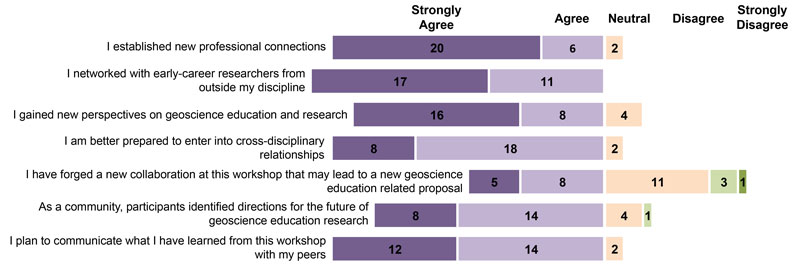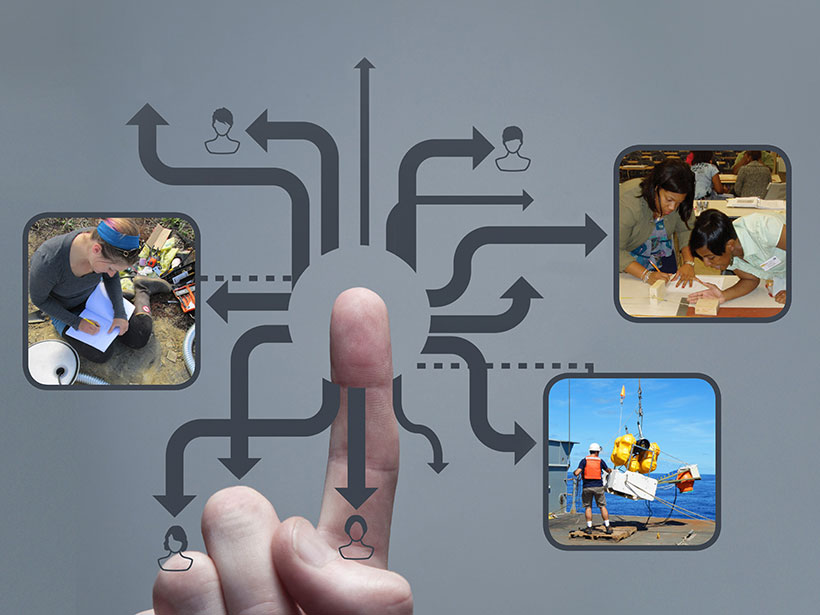The geoscience education community has made great strides in the study of teaching and learning at the undergraduate level, particularly with respect to solid Earth geology. For example, we now know that interactive strategies within lectures (such as single-concept assessments) improve students’ tests scores and that the design of geoscience visuals can hinder students’ understanding of geoscience concepts.
Nevertheless, the geosciences lag behind other science disciplines in the breadth of topics that have been studied and the application of this research to the classroom. In an effort to address these issues, early career geoscientists and geoscience education researchers (GERs) gathered in mid-January in Arlington, Va., for the Encouraging Networks Between Geoscience and Geoscience Education (ENGAGE) Workshop.
The workshop focused on promoting greater use of education research in the geosciences.
The workshop focused on promoting greater use of education research in the geosciences and encouraging relationships between GERs and researchers in various disciplines such as the Earth, atmospheric, ocean, and polar sciences. Thirty-three participants were selected from more than 100 applications on the basis of disciplinary diversity and demonstrated interest in geoscience education research.
Participants discussed the nature of science and the challenges of training students in various geoscience disciplines. After a variety of activities designed to build a shared understanding of geoscience education research, participants began brainstorming projects that explore geoscience education research question such as how field-based learning impacts students’ perception of space in remote sensing imagery. Invited speakers and panelists also provided examples of successful cross-disciplinary collaborations on such projects.
Attendees agreed that the workshop provided ample networking opportunities and prepared them for future collaborations (Figure 1). Specifically, the physical geoscientists valued the chance to collaborate on project development, whereas the GERs said they welcomed the discussion of the boundaries between outreach, evaluation, and research. GERs also found useful the discussions of potential next steps to advance geoscience education.

Workshop attendees developed a list of recommendations to advance geoscience education research. Key among those were the following:
- [pullquote float=”right”]Participants envisioned a cross-directorate program that would build scholarship in both the disciplinary and education research domains.[/pullquote]dedicated National Science Foundation funding mechanisms that could support geoscientists in their research and GERs in studying domain learning to enable both communities to dedicate time to advancing geoscience education; the participants envisioned a cross-directorate program that would build scholarship in both the disciplinary and education research domains
- future opportunities to further build collaborations between geoscientists and GERs to broaden the scope of topics receiving attention in geoscience education literature
- recognition of geoscience education research as a scholarly endeavor that contributes to the geosciences and is worthy of consideration in tenure and promotion evaluations; the early career participants acknowledged the need for GERs in geology departments to both strengthen instructional practices and promote further scholarly work on how to best train geoscience students
The full ENGAGE Workshop report is available online.
Support for the ENGAGE workshop was provided by National Science Foundation awards EAR-1425893 and EAR-1425927.
—Nicole D. LaDue, Department of Geology and Environmental Geosciences, Northern Illinois University, DeKalb, Ill.; email: [email protected]; and John Taber and Michael Hubenthal, Incorporated Research Institutions for Seismology, Washington, D. C.
Citation: LaDue, N. D., J. Taber, and M. Hubenthal (2015), Promoting new collaborations for education research in geoscience, Eos, 96, doi:10.1029/2015EO032123. Published on 26 June 2015.

